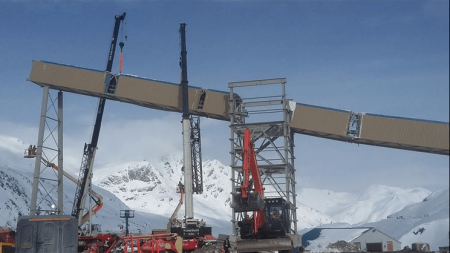

The lift study must be completed by competent personnel and include the crane selection criteriaĬranes should be of the same type (i.e. Alice Edwards from Crane Industry Council of Australia provides more detail on this, and I encourage you to take a look at her information at Some of the other key components of the Lift Plan that must be taken into consideration are:Ī site visit to understand the environment, overhead structures, ground conditions, access and site restrictions etc. In all options above, note the load may not always be even, thus load sharing must be taken into consideration. The result of this calculation will provide the required capacities for each crane. The percentage depends on the number of cranes involved in the lift, depicted as follows for each crane:Ģ cranes – add 20% of the calculated share of the loadģ Cranes – add 33% of the calculated share of the loadĤ or more cranes - add 50% of the calculated share of the load You must understand the load share for each crane, the total weight of everything under the boom head (including the hook, rigging, spreader beams, equalising devices etc.) and then add a percentage factor to the total lift load. The most important thing to note in your lift plan is that tandem lifts require you to make specific calculations about the required capacity of the cranes. In other words, plan the works thoroughly well before the work commences. As a result, tandem lifts must be planned and carried out under a competent person’s supervision.Īs always, multiple lift operations must be preceded by a documented risk assessment that records known hazards and details the relevant controls. Lifts involving two or more cranes are complex operations requiring considerable skill and planning.


This list is by no means exhaustive but does represent some of the key areas of consideration for tandem lifts. Ground preparation and the compounding ground pressures if cranes are close to each otherĪppropriate use of lift rigging or equaliser beams Side loads/forces acting on the crane boom or unintended load distribution Real-time information and communication for operators to ensure lift and travel is carried out in unison These incidents reveal critical areas of required understanding when planning a multi-crane lift:Īppropriate load planning for tandem lifts (more on that later) We have come across many tragic incidents from all across the world that involved multiple cranes, a few of which are profiled in this issue of Lifting Matters. Therefore, we are concentrating on most of the lifts that utilise mobile cranes. However, it is not practical in the mobile crane world. As outlined in AS 2550.1, clause 1.4.13, a Synchronized motion means “ Two or more crane motions under the control of a single command output with bi-directional communication so that the behaviour of one motion causes identical behaviour of the others”, which means they are electrically or mechanically connected – something that overhead and gantry cranes can achieve. Note, we are not talking about synchronised lifts here. Upending a vertical vessel using two cranes, one at the top end and a tailing crane on the bottom end is also considered a multi-crane lift. Put simply, multi-crane lifts are those which involve two or more cranes to support a load either with hooks attached directly to the load by slings, through shackles attached to pad eyes, or directly to an equaliser beam. I encourage you to do your own research in this regard, but I will attempt to provide some general things to be considered when planning and executing a multi-crane lift. Therefore, I must preface this article by saying it will not be possible for me to outline the specific requirements of your local region. Guidelines differ between states and countries. There is also often a layer of state or local guidelines to meet, which can be at odds with national standards. The Australian Standards or international equivalents can be difficult to interpret. As an industry, we generally struggle with multiple crane lifts. Multiple crane lifts are among the most technically complex lifts to plan and execute. It’s always important to properly plan any lift, but even more so when there are several cranes involved. It figures – right? Double the equipment, double the personnel, double the consequences! The complex nature of lifts involving multiple mobile or crawler cranes makes them particularly hazardous. When there are two or more cranes involved in an incident, the impact and outcome of the incident is often magnified. Several of the most high-profile crane accidents of recent times have been those involving multiple cranes (also referred to as tandem lifts).


 0 kommentar(er)
0 kommentar(er)
